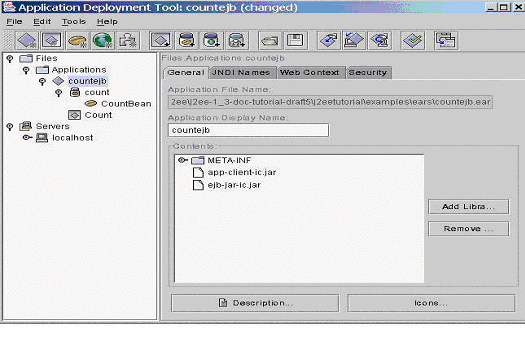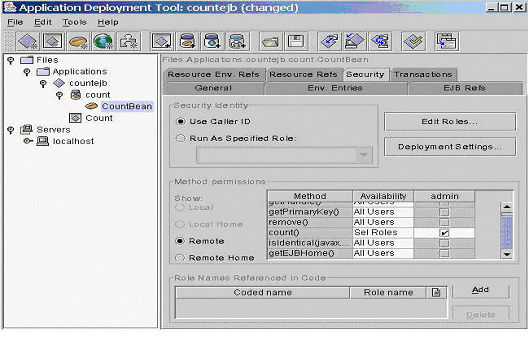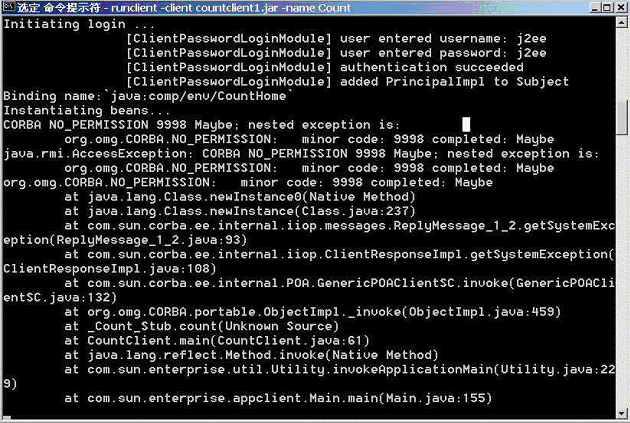从j2ee1.3开始便提供了对ejb的方法进行授权的安全服务,这种授权服务由ejb容器实现。当调用者调用ejb的方法时,ejb容器用调用者的身份来查找授予此调用者的访问权限条目,如果调用者调用的方法属于授权条目,那么ejb容器调用方法。否则,ejb容器拒绝调用此方法,并向调用者返回拒绝访问异常。可以对远程方法和home接口方法进行授权。本例中我们将对一个远程方法和一个home接口方法进行授权。
2
3 远程接口 Count.java
4
5 import javax.ejb.*;
6
7 import java.rmi.RemoteException;
8
9 public interface Count extends EJBObject {
10
11 /**
12
13 * 远程方法count
14
15 */
16
17 public int count() throws RemoteException;
18
19 }
20
21 Home接口 CountHome.java
22
23 import javax.ejb.*;
24
25 import java.rmi.RemoteException;
26
27 /**
28
29 * This is the home interface for CountBean.
30
31 * One create() method is in this Home Interface, which
32
33 * corresponds to the ejbCreate() method in the CountBean file.
34
35 */
36
37 public interface CountHome extends EJBHome {
38
39 /*
40
41 * This method creates the EJB Object.
42
43 *
44
45 * @param val Value to initialize counter to
46
47 *
48
49 * @return The newly created EJB Object.
50
51 */
52
53 Count create(int val) throws RemoteException, CreateException;
54
55 }
56
57 实现类 CountBean.java
58
59 import javax.ejb.*;
60
61 import java.security.Principal;
62
63 /**
64
65 public class CountBean implements SessionBean {
66
67 // The current counter is our conversational state.
68
69 public int val;
70
71 private SessionContext sessionCtx;
72
73 //
74
75 // 远程商业方法实现
76
77 public int count() {
78
79 System.out.println("count()");
80
81 return ++val;
82
83 }
84
85 //
86
87 // home接口Create方法的实现
88
89 //
90
91 public void ejbCreate(int val) throws CreateException {
92
93 this.val = val;
94
95 System.out.println("ejbCreate()");
96
97 }
98
99 public void ejbRemove() {
100
101 System.out.println("ejbRemove()");
102
103 }
104
105 public void ejbActivate() {
106
107 System.out.println("ejbActivate()");
108
109 }
110
111 public void ejbPassivate() {
112
113 System.out.println("ejbPassivate()");
114
115 }
116
117 public void setSessionContext(SessionContext ctx) {
118
119 sessionCtx=ctx;
120
121 }
122
123 }
124
125 客户端程序 CountClient.java
126
127 import javax.ejb.*;
128
129 import javax.naming.*;
130
131 import java.util.Properties;
132
133 /**
134
135 * This class is a simple example of client code.
136
137 */
138
139 public class CountClient {
140
141 public static void main(String[] args) {
142
143 try {
144
145 InitialContext ctx = new InitialContext();
146
147 CountHome home = (CountHome)
148
149 javax.rmi.PortableRemoteObject.narrow(
150
151 ctx.lookup("java:comp/env/CountHome"), CountHome.class);
152
153 int countVal = 0;
154
155 Count count=null;
156
157 /*
158
159 创建并执行远程方法
160
161 */
162
163 System.out.println("Instantiating beans...");
164
165 count = home.create(countVal);
166
167 countVal = count.count();
168
169 System.out.println(countVal);
170
171 /*
172
173 remove Count对象
174
175 */
176
177 count.remove();
178
179 } catch (Exception e) {
180
181 System.out.println(e.getMessage());
182
183 e.printStackTrace();
184
185 }
186
187 }
188
189 }
190
191
这个ejb包括一个远程商业方法count(),我们将将此方法授权给某个安全角色。此外还将home接口的Create()方法授权给安全角色。
步骤1
编译以上源程序并用j2sdkee1.3.1的组装发布工具(deploytool.bat)进行组装(如图12)。
图12

步骤2:配置安全角色
在对方法进行授权前,必须创建将被授权的安全角色。创建安全角色的步骤前边已经介绍过了,此处不再重复。本例中我们创建名为admin的安全角色。
步骤3:方法授权
方法授权的过程是确定那些安全角色可以访问特定方法的过程。方法授权一般是应用程序组装或应用程序部署者的责任。他们根据企业特定的需求创建不同的安全角色,并授予这些安全角色特定的访问权限。
用鼠标选中CountBean,在右端的窗口选择Security属性页(如图13),在Security Identity选项中选择Use Caller ID,这意味着ejb容器将用方法调用者的身份来验证方法调用权限。 Run As Specified Role选项将在"传播调用者身份标识的例子"进行介绍。由于在前面创建了admin安全角色,因此你可以看到Method Permissions栏中出现admin列。首先对远程方法count()进行授权。选择Remote选项,并在count()方法的Availability列中选择Sel Roles,然后选中count()方法的admin列。到此为止我们已对远程方法count()进行了授权。接下来对home接口的create()方法进行授权。在Show栏中选择Remote Home,剩下的步骤与count()方法授权相同。我们已经将count()方法和create()方法授权给了admin安全角色。但安全角色这是一个逻辑的集合,并不代表具体的用户或用户组,因此结下来我们要做的就是将安全角色与实际的用户映射起来。
步骤4:角色映射
首先我们需要在我们的j2ee环境中创建一个用户,用户起名为Tony,密码为1。
图13

这里我们使用用户名和密码的方式进行身份验证。我们在default Realm中创建此用户。可以使用命令行方式:"realmtool -add Tony 1 eng"。详细的使用方法参见j2sdk1.3.1文档的工具部分。接下来映射安全角色到用户。选中ejb应用CountEjb,在右边窗口中选择Security属性页(如图14),点击Edit Roles按钮,选择安全角色admin。再点击Add按钮选择Tony用户。这样已经将安全角色admin和用户Tony映射起来了。
步骤5:部署应用
部署应用到本地机,右键点击ejb应用CountEjb,选择弹出菜单的deploy项,按要求配置各项。
步骤6:创建客户端
创建客户端将客户端程序的主类和其他辅助类打包。创建端将客的过程比较简单,这里就不作描述了。
步骤7:运行程序
现在可以运行客户端程序来验证方法的授权了。通过命令runclient.bat -client客户端jar包文件名 -name 主类名来执行客户端程序。客户端程序的容器将显示一个对话框来提示用户输入用户名和密码(如图15),填写用户名和密码,按OK。
图15

若用户名或密码与授权的方法不符,则会抛出没有权限异常(如图16)。
图16

Countejb的部署描述文件ejb.xml
2 <!DOCTYPE ejb-jar PUBLIC
3 '-//Sun Microsystems, Inc.//DTD Enterprise JavaBeans 2.0//EN'
4 'http://java.sun.com/dtd/ejb-jar_2_0.dtd'>
5 <ejb-jar>
6 <display-name>count</display-name>
7 <enterprise-beans>
8 <session> // CountBean属于session bean
9 <display-name>CountBean</display-name> //ejb组件的显示名
10 <ejb-name>CountBean</ejb-name> //ejb组件名
11 <home>CountHome</home> //Home接口
12 <remote>Count</remote> //远程接口
13 <ejb-class>CountBean</ejb-class> //实现类
14 <session-type>Stateful</session-type> // CountBean属于Stateful Bean
15 <transaction-type>Container</transaction-type> //CountBean事务类型为容器管理的
16 <security-identity> //安全标识
17 <description></description>
18 <use-caller-identity></use-caller-identity> //CountBean使用调用者的身份标识
19 </security-identity>
20 </session>
21 </enterprise-beans>
22 <assembly-descriptor>
23 <security-role>
24 <role-name>admin</role-name> //定义安全角色admin
25 </security-role>
26 <method-permission> //将方法count和remove授权给安全角色admin
27 <role-name>admin</role-name>
28 <method> //方法定义
29 <ejb-name>CountBean</ejb-name>
30 <method-intf>Remote</method-intf>
31 <method-name>count</method-name>
32 <method-params />
33 </method>
34 <method>
35 <ejb-name>CountBean</ejb-name>
36 <method-intf>Home</method-intf>
37 <method-name>remove</method-name>
38 <method-params>
39 <method-param>java.lang.Object</method-param>
40 </method-params>
41 </method>
42 </method-permission>
43 <method-permission>
44 <unchecked /> //不检查以下方法的授权
45 <method>
46 <ejb-name>CountBean</ejb-name>
47 <method-intf>Remote</method-intf>
48 <method-name>getHandle</method-name>
49 <method-params />
50 </method>
51 .
52 .
53 .
54 .
55 <method>
56 <ejb-name>CountBean</ejb-name>
57 <method-intf>Remote</method-intf>
58 <method-name>getEJBHome</method-name>
59 <method-params />
60 </method>
61 </method-permission>
62 <container-transaction> // CountBean的事务属性
63 <method>
64 <ejb-name>CountBean</ejb-name>
65 <method-intf>Remote</method-intf>
66 <method-name>count</method-name>
67 <method-params />
68 </method>
69 <trans-attribute>Required</trans-attribute>
70 </container-transaction>
71 </assembly-descriptor>
72 </ejb-jar>
73


